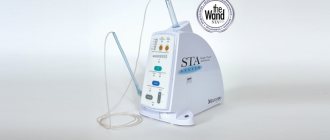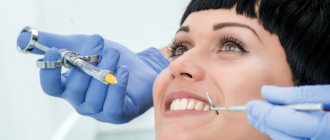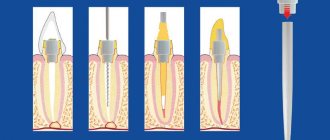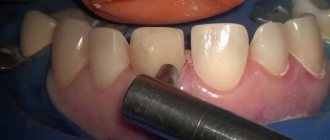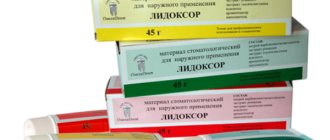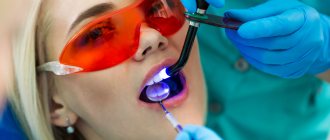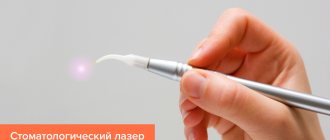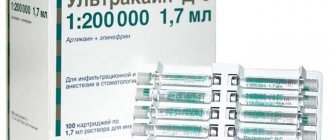Possible pain during dental treatment is the main factor that deters patients from visiting a dentist. Indeed, several decades ago, anesthetics were used that eliminated pain during doctor’s manipulations. But today, there are drugs and pain management techniques that are actively used in our clinic to eliminate possible pain even for patients with a low pain threshold.
If the fear of visiting the dentist cannot be overcome on your own, then you can use drugs that suppress anxiety. Over-the-counter products include tinctures of valerian and motherwort, Afobazol. It is advisable to take the tinctures in a course several days before the doctor’s visit. However, along with the sedative effect, they also have a pronounced hypnotic effect, which is not good for drivers and working people. Afobazole is also taken as a course, starting a week before visiting the doctor; the drug does not cause drowsiness.
General and local anesthesia
What is used for pain relief in dentistry today? Two types of anesthesia are used - general (anesthesia) and local. The first type is rare and is used for extensive jaw surgeries. Anesthesia has a large number of contraindications and possible complications, and therefore in modern clinics the choice is in favor of local anesthesia. Moreover, its current level allows us to comfortably carry out treatment of caries, pulpitis, tooth extraction, prosthetics and other work.
Local anesthesia involves anesthetizing the area of intervention - turning off pain sensitivity, the patient is conscious. In most cases, tactile sensitivity is preserved (touching the cheek, gum, tooth, sensation of vibration, and so on).
The following types of anesthesia are used in dentistry:
- Applique . Only the mucous membrane is anesthetized using a special spray or gel. The rapid anesthetic effect allows further injection without pain. Used for removing stone and interventions at the gingival margin.
- Infiltration . An injection into the gum for pain relief in the upper jaw. The injection begins to act within 3-4 minutes, the freezing lasts for about an hour. Infiltration anesthesia is used in the treatment of pulpitis, deep caries, and tooth extraction. Complete absence of pain during treatment.
- Conductor . Anesthesia of the lower tooth, injection of an anesthetic into the area of the mandibular nerve. The nerve impulse along a fairly large cluster of nerves is blocked, and therefore the tongue and part of the lower jaw become numb. Naturally, anesthesia has a reversible effect and the nerve tissue is not damaged. The effect lasts for about two hours. Intraligamentary. Intraligamentous anesthesia, unlike conduction anesthesia, does not cause numbness of the tongue and part of the jaw, and therefore is actively used in pediatric dentistry when treating cavities and removing teeth. In adult patients, anesthesia is ineffective.
Experience in the clinical use of local anesthetics based on mepivacaine
A. V. Kuzin
Candidate of Medical Sciences, dental surgeon of the Federal State Institution "Central Research Institute of Infrastructure and Maxillofacial Surgery" of the Ministry of Health of the Russian Federation, consultant physician at 3M ESPE on pain management in dentistry
M. V. Stafeeva
dentist-therapist, private practice (Moscow)
V. V. Voronkova
Candidate of Medical Sciences, Dentist-Therapist, Department of Therapeutic Dentistry, Clinical Diagnostic Ministry of Health of Russia
Often in clinical practice there is a need to use short-acting anesthetics. There are many low-volume dental procedures that require pain relief. The use of long-acting anesthetics is not entirely legal, since the patient leaves the dentist with numbness in a certain area of the oral cavity lasting from 2 to 6 hours.
Taking into account the labor and social load on the patient, the use of short-acting anesthetics is justified, which can reduce the duration of soft tissue numbness to 30-45 minutes. Today in dentistry, local anesthetics based on mepivacaine meet these requirements.
Mepivacaine is the only amide anesthetic that can be used without the addition of a vasoconstrictor. Most amide anesthetics (articaine, lidocaine) dilate the blood vessels at the injection site, which leads to their rapid absorption into the bloodstream. This shortens the duration of their action, which is why dosage forms of anesthetics are available with epinephrine. In the Russian Federation, lidocaine is produced in ampoules without vasoconstrictors, which requires its dilution with epinephrine before use. According to modern standards of pain management in dentistry, the preparation of a local anesthetic solution by staff is a violation of the anesthesia technique. 3% mepivacaine has a less pronounced local vasodilator effect, which allows it to be effectively used to anesthetize teeth and soft tissues of the oral cavity (Table No. 1).
The duration of action of mepivacaine-containing anesthetics (mepivastezin) varies in individual areas of the oral cavity. This is due to some features of its pharmacological action and features of the anatomy of the oral cavity. According to the instructions of the local anesthetic, the duration of anesthesia for the dental pulp is on average 45 minutes, anesthesia for soft tissues - up to 90 minutes. These data were obtained as a result of an experimental study in practically healthy patients during anesthesia of single-rooted teeth, mainly in the upper jaw. Naturally, such studies do not reflect real clinical conditions in which a dentist is faced with inflammatory phenomena in tissues, chronic neuropathic pain, and the individual characteristics of the patient’s anatomy. According to domestic scientists, it was found that the average duration of dental pulp anesthesia when using 3% mepivacaine is 20-25 minutes, and the duration of soft tissue anesthesia depends on the volume of anesthetic administered and the anesthesia technique (infiltration, conduction) and is 45-60 min.
An important issue is the speed of onset of local anesthesia. Thus, when using 3% mepivacaine, the rate of onset of dental pulp anesthesia is 5-7 minutes. Therapeutic dental treatment will be most painless for the patient from the 5th to the 20th minute after anesthesia. Surgical treatment will be painless from the 7th to the 20th minute after local anesthesia.
There are some peculiarities in the anesthesia of certain groups of teeth with 3% mepivacaine. Numerous studies have proven that it is most effective in relieving pain in single-rooted teeth. The incisors of the upper and lower jaws are anesthetized with infiltration anesthesia with 3% mepivacaine in a volume of 0.6 ml. In this case, it is important to take into account the topography of the apexes of the roots of the teeth and, accordingly, the depth of advancement of the carpule needle into the tissue. For anesthesia of canines, premolars and molars of the upper jaw, the authors recommend creating an anesthetic depot of 0.8-1.2 ml. Mandibular premolars respond well to anesthesia with 3% mepivacaine: submental anesthesia is performed in various modifications, where an anesthetic depot of up to 0.8 ml is created. It is important after submental anesthesia to apply digital pressure to the soft tissues above the mental foramen for better diffusion of the anesthetic. Infiltration anesthesia in the area of mandibular molars with 3% mepivacaine is ineffective compared to articaine. Anesthesia of mandibular molars with 3% mepivacaine is advisable only in patients with contraindications to the use of articaine-containing anesthetics with epinephrine: in these cases, mandibular anesthesia (1.7 ml of 3% mepivacaine) must be performed. Mandibular canines are also anesthetized with chin or mandibular anesthesia in patients with the contraindications described above.
As a result of many years of experience in the clinical use of mepivacaine, indications and clinical recommendations for its use have been developed. Of course, mepivacaine is not an “every day” anesthetic; however, there are a number of clinical cases when its use is most appropriate.
Patients with chronic general somatic diseases.
First of all, the use of mepivacaine is most justified in patients with cardiovascular pathology and restrictions on the use of a vasoconstrictor. If a low-traumatic intervention lasting less than 20-25 minutes is planned, there are indications for the use of 3% mepivacaine, which does not affect the patient’s hemodynamic parameters (BP, HR). If longer-term treatment or intervention is planned in the area of the mandibular molars, from a clinical point of view, the use of only articaine-containing anesthetics with a vasoconstrictor of 1:200,000 is justified.
Patients with a history of allergies.
There is a group of patients with bronchial asthma in whom the use of articaine with a vasoconstrictor is contraindicated due to the risk of developing status asthmaticus due to the preservatives contained in the carpule. Mepivacaine does not contain preservatives (sodium bisulfite), so it can be used for short-term interventions in this group of patients. For longer interventions in this group of patients, it is advisable to carry out dental treatment in specialized institutions under the guidance of an anesthesiologist. Mepivacaine can be used in patients with multivalent allergies and those allergic to a known anesthetic. Outpatient dental treatment for such patients is carried out after the conclusion of an allergist on the tolerability of the drug. According to the clinical experience of the authors of this article, the frequency of positive allergy tests for 3% mepivacaine is significantly lower in comparison with other carpulal anesthetics.
In therapeutic dentistry
mepivacaine is used in the treatment of uncomplicated caries: enamel caries, dentin caries. It is important to consider that the required duration of anesthesia is limited to the stage of preparation of hard dental tissues. After covering the formed cavity with adhesive material, further restoration will be painless. Accordingly, any planned invasive treatment should not exceed 15 minutes after the onset of anesthesia. Also, when planning treatment, one should take into account the low effectiveness of mepivacaine in anesthesia of canines and molars of the lower jaw with infiltration anesthesia and with intraligamentary anesthesia of the teeth of the lower jaw.
In surgical dentistry
mepivacaine is used for short-term surgical interventions. The greatest effectiveness was found when removing teeth with chronic periodontitis and when removing intact teeth for orthodontic indications. The role of mepivacaine in pain relief during surgical dressings is important. Often, the procedure for removing sutures, changing the wound covering in the tooth socket, and changing the iodoform dressing is painful for patients. The use of long-acting anesthetics is unjustified due to the subsequent long-term numbness of soft tissues, which can lead to self-injury of the surgical site when eating. In these cases, infiltration anesthesia is used in a volume of 0.2-0.4 ml of 3% mepivacaine, and for dressings after extensive surgical interventions (cystectomy, excision of soft tissue formations, removal of an impacted third molar), conduction anesthesia is performed. The use of mepivacaine during outpatient surgical dressings can reduce patient discomfort and stress.
Pediatric dentistry.
Short-acting anesthetics have proven themselves well when used in pediatric dentistry. When using mepivacaine, the dosage of this drug should be taken into account when performing local anesthesia in children. Mepivacaine is more toxic to the central nervous system than articaine because it is rapidly absorbed into the bloodstream. Also, the clearance of mepivacaine is higher than the clearance of articaine for several hours. The maximum dosage of 3% mepivacaine is 4 mg/kg of body weight for a child over 4 years of age (Table No. 2). However, in pediatric dentistry there are no indications for the use of such high volumes of anesthetic. According to modern safety standards, the dosage of 3% mepivacaine administered should not exceed half the maximum dose for the entire dental treatment. With this use, cases of local anesthetic overdose (weakness, drowsiness, headaches) in pediatric practice are excluded.
When using mepivacaine, cases of self-injury of the soft tissues of the oral cavity by a child after treatment at the dentist are practically excluded. According to statistics, up to 25-35% of preschool children injure the lower lip after treatment of the lower teeth, and in most cases this is associated with the use of long-acting anesthetics based on articaine with a vasoconstrictor. Short-acting local anesthetics can be used when sealing dental fissures, treating initial forms of caries, and removing temporary teeth. The use of mepivacaine in children with polyvalent allergies and bronchial asthma is especially justified, since the drug does not contain preservatives (EDTA, sodium bisulfite).
Pregnancy and breastfeeding.
Mepivacaine can be safely used in pregnant women during routine sanitation of the oral cavity at the dentist according to the indications described above. In most cases, 3% mepivacaine is used for short-term and minimally invasive interventions lasting up to 20 minutes. The second trimester of pregnancy is most favorable for treatment.
Mepivacaine can be used in breastfeeding women; it is found in mother's breast milk in concentrations that are insignificant for the child. However, the patient is recommended to refrain from feeding the child for 10-12 hours after anesthesia with 3% mepivacaine and for 2 hours after anesthesia with 4% articaine with epinephrine, which completely eliminates the effect of the anesthetic on the child.
conclusions
Thus, mepivacaine-containing anesthetics (Mepivastezin) have found their use in various fields of dentistry. For a certain group of patients, these anesthetics are the only drugs for local anesthesia due to general somatic features. As a short-acting anesthetic, the drug can be well used for minimally invasive short-term interventions.
Table No. 1. Features of the clinical use of 3% mepivacaine (Mepivastezin)
| The onset of anesthesia for single-rooted teeth is 5 minutes, for multi-rooted teeth - 7 minutes |
| Therapeutic invasive treatment is carried out from the 5th to the 20th minute after anesthesia; surgical treatment should be carried out from the 7th to the 20th minute after anesthesia |
| Does not affect the patient's hemodynamic parameters (BP, heart rate). Drug of choice in patients with relative contraindications to the use of vasoconstrictors |
| Indicated for patients with bronchial asthma, hypersensitivity to sulfites, polyvalent allergies |
Table No. 2. Dosage of 3% mepivacaine based on patient weight (adult/child)
| Weight | Mg | Ml | Carpools |
| 10 | 44 | 1.5 | 0.8 |
| 15 | 66 | 2.2 | 1.2 |
| 20 | 88 | 2.8 | 1.4 |
| 25 | 110 | 3.6 | 1.7 |
| 30 | 132 | 4.4 | 2.4 |
| 35 | 154 | 5.1 | 2.9 |
| 40 | 176 | 5.9 | 3.2 |
| 45 | 198 | 6.6 | 3.6 |
| 50 | 220 | 7.3 | 4.0 |
| Mepivacaine 3% without vasoconstrictor. Maximum dose 4.4 mg/kg; 3% solution in 1 carpule 1.8 ml (54 mg) | |||
About carpuled anesthetics, syringes and needles for local anesthesia
Dental centers, including ours, use not ampoule, but carpule anesthetics of the latest generations. The drugs are in special containers - cartridges, which are inserted into a carpule syringe. The thinnest disposable needles are used for syringes. Carpuled anesthetics are used by doctors taking into account pharmacological characteristics, including additives.
The carpule syringe is easy to use, allows you to take an aspiration sample, insert a needle and inject with one another. It can be easily sterilized in an autoclave, which is used by most dentists. Ease of use reduces the risk of intravascular injection and needle deviation in tissue from the chosen trajectory.
The needle is fixed using a thread of European or American standard. Naturally, all consumables are absolutely sterile, their tips are in excellent condition - sharpened and specially coated, making the injection less traumatic.
Advantages of anesthesia using carpuled anesthetics:
- Absolute sterility. The ampoule does not open, and therefore there is no contact of the solution with the air.
- Exact dosage. All drugs, including those that protect the anesthetic from decay, are in the required dosages.
- No pain. The needle of the syringes is thinner than regular ones and has a special angle and sharpening pattern, which reduces the pain sensation to almost zero.
